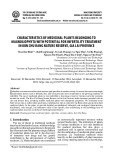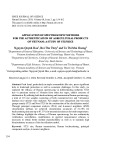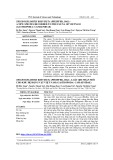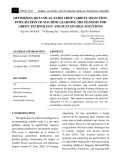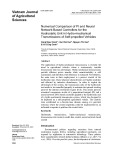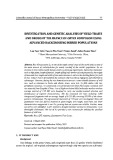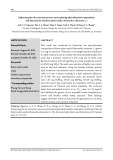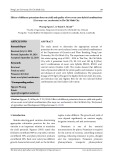
Tập 18 Số 5-2024, Tạp chí Khoa học Tây Nguyên
1
AN OVERVIEW OF THE POTENTIAL APPLICATION OF PRODIGIOSIN IN
CONTROL OF PLANT PATHOGENIC ORGANISMS
Nguyen Van Bon1, Truong Ba Phong2
Received Date: 12/09/2024; Revised Date: 06/10/2024; Accepted for Publication: 07/10/2024
ABSTRACT
Prodigiosin (PG) is a red pigment mainly biosynthesized by Serratia marcescens. This pigment
compound possesses potential applications in various fields. Due to showing various bioactivities, PG has
received much attention for study. Numerous review papers concerning the production and applications
of PG were reported. However, almost all previous reviews focus on its potential application in medicine.
To date, PG has been widely investigated for its application in agriculture with plant anti-pathogenic
potent against nematodes, fungi, and bacteria. To highlight the novel and promising utilization of PG in
agriculture, this review extensively presented and discussed the applications of PG in agriculture via in
vitro tests, greenhouse tests, and field studies. The mechanism action of PG was also presented in this
paper.
Keywords: Bactericidal effect, fungicidal effect, nematicidal effect, prodigiosin, S. marcescens.
1. INTRODUCTION
PG, a red pigment compound, is a prodigionine
compound with a pyrrolylpyrromethane skeleton
(Darshan N., et al., 2015). The structure and
some basic physicochemical properties of PG are
presented in Figure 1. PG was biosynthesized by
various microbial strains, of these, S. marcescens
was reported as a major PG-producing strain
(Wang S.L. et al., 2020). This bacterial pigment
compound has been reported to show potential
applications in various fields, including medicine,
food, industry, environment, and agriculture
(Wang S.L. et al., 2020; Shaikh Z., 2016; Islan
G.A. et al., 2022). In addition, the safety of PG
was also confirmed previously (Li X. et al., 2021;
Nguyen V.B. et al., 2020; Siew W.S. et al., 2016;
Suryawanshi R.K. et al., 2014; Guryanova I.D. et
al., 2013; Tomas R.P. et al., 2010).
Figure 1. The structure and basic physico-
chemical properties of PG
Recently, the studies on PG have increased
dramatically due to its numerous benefits (Nguyen
V.B. et al., 2020). This compound was extensively
studied for its biosynthesis using various substrates,
including commercial broth, agro-products, agro
by-products, as well as organic wastes (Wang
S.L. et al., 2020). The condition fermentation, and
additive agents for enhancing PG productivity via
fermentation were studied (Han R. et al., 2021).
For scaling-up of PG productivity, bioreactor
systems with various working volumes were also
investigated. Until now, there have been many
overview works on PG. However, almost focus
on its potential applications in medicines (Wang
S.L. et al., 2020; Islan G.A. et al., 2022; Han R.
et al., 2021; Rafael G.A. et al., 2022; Mnif S. et
al., 2022), several review papers focused on some
aspects such as the general biosynthesis pathway
of PG and physical-chemical characteristics (Han
R. et al., 2021; Rafael G.A. et al., 2022; Anita
K. et al., 2006), or high-level PG biosynthesis
(Wang S.L. et al., 2020; Islan G.A. et al., 2022;
Han R. et al., 2021; Rafael G.A. et al., 2022;
Mnif S. et al., 2022). To highlight the novel and
promising utilization of PG in agriculture, this
review extensively presented and discussed the
applications of PG in controlling major plant
pathogenic organisms, including nematodes,
insects, bacteria, and fungi. The mechanism action
of PG for medical effects has been investigated
in many reports. However, the mechanism action
of PG for bioactivities in controlling major plant
pathogenic organisms were just reported in several
1Institute of Biotechnology and Environment, Tay Nguyen University;
2Faculty of Natural Science and Technology, Tay Nguyen University;
Corresponding author: Nguyen Van Bon; Tel: 0842458283; Email: nvbon@ttn.edu.vn.

Tập 18 Số 5-2024, Tạp chí Khoa học Tây Nguyên
2
works. Concerning the mechanism action of PG
on nematodes was investigated by Roser F. et
al. (2007), Nguyen, T.H., et al. (2024), Nguyen,
T.H., et al. (2024). The mechanism action of PG
against fungi was reported by Hazarika D.J. et al.
(2020), Nguyen, V.B. et al. (2023), and Nguyen,
T.H. et al. (2024). Several reports also proposed
the possible mechanism action of PG against
bacteria (Danevcic T. et al., 2016; Kimyon, O. et
al. 2016; Danevčič T. et al., 2016; Yip C.H. et al.,
2021). To highlight this issue needs to be further
investigated, the mechanism action of PG was also
presented and discussed in this paper.
Up to now, several derives of PG were also
found to be produced by bacteria (Eckelmann
D. et al., 2018; Klein A.S. et al. 2017&2018) or
obtained from chemoenzymatic synthesis (Tim
M.W. et al., 2023). These PG derives showed
some bioactivities, including good effects against
Nematodes and Fungi. However, investigations
of PG derives is still rare. Thus in this paper,
we focused on presenting and discussing the
application of PG.
2. NEMATICIDAL EFFECT OF PG
Up to date, PG has been found as a nematicidal
compound against several nematodes, including
Radopholus similis, Meloidogyne javanica (Rahul
S. et al., 2014), Caenorhabditis elegans,
Heterodera schachtii (Samer S.H. et al., 2020),
Meloidogyne incognita (Omnia M.M. et al., 2020),
and Black pepper Meloidogyne spp. (Nguyen T.H.
et al., 2022; Nguyen T.H. et al., 2024) (Table 1).
The first study evaluating the nematicidal effect
of PG was reported by Rahul, S., et al. (2014), in
this work, PG was found to potentially inhibiting
against R. similis and M. javanica with low IC50
values of 0.083 and 0.079 mg/ml, respectively.
PG demonstrated even higher activity compared
to a positive control - copper sulphate (IC50 value
of 0.38 and 0.23 mg/ml, respectively). In 2020,
PG was evidenced as the most active compound
among the prodigiosin structures in nematicidal
effect against C. elegans and H. schachtii (Samer
S.H. et al., 2020). PG showed a potential effect
on C. elegans and moderate activity against H.
schachtii with IC50 values of 0.127 and 13.3 μM,
respectively.
Recently, PG was also found as a novel
nematicidal compound of root-knot nematodes
(Omnia M.M. et al., 2020; Nguyen T.H. et al.,
2022; Nguyen T.H. et al., 2024). This pigment
showed a moderate effect against M. incognita
with the highest inhibition (84%) at the tested
concentration of 100 mg/ml, and the IC50 value
was recorded at 31.9 mg/ml. Nearby, PG was
produced at a high-level yield and found as an
effective nematicidal agent against black pepper
Meloidogyne spp.
This purified pigment effectively inhibited J2
nematode Meloidogyne spp. and egg-hatching
with max values of 96.7 and 87%, with low IC50
values of 0.2 and 0.32 mg/ml, respectively. PG
was further nanozationized to enhance nematicidal
effect and stability (Nguyen T.H. et al., 2024). The
result showed that nano/micro-PG demonstrated a
strong effect on both eggs and J2 nematodes with
IC50 values of 0.85 and 0.38 mg/ml, respectively,
besides, the nematicidal effect of nano/micro-PG
was improved by about 4-folds compared with
pure PG.
Several studies were conducted in greenhouses
and in the fields for investigation of the effect of
PG on preventing plant pathogenic diseases and
showed its plant-promoting effect and got positive
results. In the work of Samer, S.H., et al. (2020),
PG reduced approximately 50% of the total
number of individual H. schachtii development in
the Arabidopsis thaliana plant and also promoted
the growth of the plant depending on treatment
concentration. Some studies also assessed the role
of PG on root-knot nematode in the greenhouse
condition. Omnia, M.M., et al. (2020) used the
culture broth and culture filtrate of S. marcescens
for testing the effect against Meloidogyne incognita
inhibition in-vivo on tomato seedlings and found
that all the treatments showed a significant decrease
in the nematode population, in soil and tomato root.
The shoot and root lengths and plant biomass were
found to increase significantly in comparison to
that in the untreated plants. In the study conducted
by Nguyen, D.N., et al. (2020), the fermented
culture broth of S. marcescens TNU02 with high
PG content (at the treatment dose of 80 mL) was
used for testing the nematicidal effect against
M. incognita on the black pepper plant model
in greenhouse conditions and showed potential
effect against nematodes in soil and pepper root
with mortality rates of 85% and 70%, respectively.
Forty mL and 80 mL of the fermented culture
broth had a more potent plant-promoting effect
than other treatments at other concentrations.
Recently, purified PG was assessed for its effect
on orange orchards Asian Citrus psyllid (Wei H.
et al., 2021) and reported that at 10% emulsifiable
concentration demonstrated more effectiveness
with inhibition values up to 70-100% than other
concentrations. The potency recorded in July and

Tập 18 Số 5-2024, Tạp chí Khoa học Tây Nguyên
3
August was better than that recorded in October.
3. INSECTICIDAL EFFECT OF PG
In the aspect of insect management, PG was
reported inhibition against some insects such as
Plutella xylostella, Spodoptera litura, Adoxophyes
honmai (Asano S. et al., 1999; Wang S.L. et al.,
2012), Drosophila (Wang S.L. et al., 2012; Liang
T.W. et al., 2013), Diaphorina citri (Wei H. et
al., 2021), Spodoptera litura and Helicoverpa
armigera (Patil N.G. et al., 2013).
Table 1. Nematicidal and Insecticidal effect of PG
Pathogenic strains Activity unit Value Reference
Nematicidal effect
Radopholus similis Anti - J2 nematode, IC50, mg/ml 0.083 Rahul, S., et al. 2014
Meloidogyne javanica Anti - J2 nematode, IC50, mg/ml 0.079 Rahul, S., et al. 2014
Caenorhabditis elegans Anti – J1 nematode, IC50 (μM) 0.127 Samer, S.H., et al. 2020
Heterodera schachtii Anti – J2 nematode, IC50 (μM) 13.3 Samer, S.H., et al. 2020
Meloidogyne incognita
Meloidogyne incognita
Anti - J2 nematode - % (at 100 mg/
ml)
84 Omnia, M.M., et al. 2020
Anti - J2 nematode, IC50, mg/ml 31.9 Omnia, M.M., et al. 2020
Meloidogyne spp.
Meloidogyne spp.
Meloidogyne spp.
Meloidogyne spp.
Anti - J2 nematode, IC50, mg/ml 0.2 Nguyen, T.H., et al. 2022
Anti - J2 nematode, % (at 0.5mg/ml) 96.7 Nguyen, T.H., et al. 2022
Anti egg-hatching (IC50, mg/mL) 0.32 Nguyen, T.H., et al. 2022
Anti egg-hatching (%, at mg/ml) 87 Nguyen, T.H., et al. 2022
Black pepper Meloido-
gyne spp.
Anti - J2 nematode, IC50, mg/ml 0.018
0.004*
Nguyen, T.H., et al. 2024
Black pepper Meloido-
gyne spp.
Anti egg-hatching (IC50, mg/mL) 0.013
0.003*
Nguyen, T.H., et al. 2024
Insecticidal effect
Plutella xylostella The mortality, %, at 8 µg/g diet 100 Asano, S., et al. 1999
Spodoptera litura The mortality, %, at 8µg/g diet 34 Asano, S., et al. 1999
Adoxophyes honmai The mortality, %, at 8µg/g diet 12 Asano, S., et al. 1999
Drosophila Survival rate, %, at 1.2µg/ml 0Wang, S.L., et al. 2012
Drosophila Anti larval, IC50, (g/L-1)0.23 Wang, S.L., et al. 2012
Drosophila Anti larval, IC50, ppm 230 Liang, T.W., et al. 2013
Diaphorina citri Inhibitory rate of oviposition (%), at
40mg/L
42 Wei, H., et al. 2021
Diaphorina citri Inhibitory rate of egg hatch (%), at at
40mg/L
26 Wei, H., et al. 2021
Spodoptera litura Larval mortality rate (%), at 30mg/ml 100 Patil, N.G., et al. 2023
Helicoverpa armigera Larval mortality rate (%), at 20g/ml 70 Patil, N.G., et al. 2023
Note: * the activity of nano/micro-prodigiosin.
PG was early evaluated in its effect on several
insect species, including Plutella xylostella,
Spodoptera litura, Adoxophyes honmai by Asano,
S., et al. (1999). Of these PG effectively inhibited
Plutella xylostella with a great mortality rate of
100% at a tested concentration of 8 µg/g diet,
while it showed moderate and low effect against
Spodoptera litura, Adoxophyes honmai with a
mortality rate of 34% and 12%, respectively at
the same tested concentration. In the year 2012,
Wang, S.L., et al. conducted a study concerning
the enhanced production of insecticidal
prodigiosin from S. marcescens TKU011 in media
containing squid pens and reporting its potential
insecticidal effect against Drosophila. The record
result indicated that PG showed a high effect on
Drosophila with a survival rate of 0 % at the tested
concentration of 1.2 µg/ml, and the anti Drosophila
larval effect was recorded with a low IC50 value of
0.23 g/L.

Tập 18 Số 5-2024, Tạp chí Khoa học Tây Nguyên
4
Recently, Wei, H. et al. (2021) tested the
potential use of PG for the management of Asian
Citrus Psyllid. The toxicity of PG against nymphs
depends on temperature and the most suitable
temperature was 30°C based on tested results.
This pigment compound was found effective
against Diaphorina citri and moderate anti-egg
hatching with an inhibitory rate of 42% and 26%,
respectively. In addition, the treatments with IC20
and IC50 solution of purified PG at 30°C against adult
hoppers were recorded to excrete less honeydew
compared with the control. Most recently, Patil,
N.G., et al. 2023 reported the potential effect
of PG against two species of insects, including
Spodoptera litura and Helicoverpa armigera with
potential Larval mortality rate of 100% and 70% at
the tested concentration of 30 mg/ml and 20 mg/
ml, respectively. Though PG was confirmed as
an agent having potential in the management of
some insects, a few studies on the greenhouse and
field conditions were conducted to evaluate the
applicability of PG.
4. ANTI PATHOGENIC MICROBES
4.1. Bactericidal effect of PG
Up to date, PG has been reported to be a
potential bactericidal agent against numerous
pathogenic bacterial strains, such as inhibiting
against P. aeruginosa (Ma Z. et al., 2024), E.
coli NCIM 2065, K. pneumoniae NCIM 2706,
P. aeruginosa NCIM 2036, B. subtilis NCIM
2545, MRSA ATCC 43300 (Arivuselvam R.
et al., 2023), Listeria monocytogenes, Bacillus
cereus, Pseudomonas aeruginosa, Salmonella
typhimurium, Staphylococcus aureus, and
Vibrio parahaemolyticus (Ji K. et al., 2019),
Pseudomonas aeruginosa, Staphylococcus aureus
and Chromobacterium violaceum (Gohil N. et
al., 2020), S. aureus, E. coli and E. faecalis (Yip
C.H. et al., 2021). However, almost all previous
works evaluated the effect of PG against bacterial
strains infected to humans. Few studies assessed
the potential application of PG in inhibiting plant
pathogenic bacteria. Only one study conducted by
Hiroshi, O. et al. (1998) tested the potential effect
of PG against some plant pathogenic bacteria. In
this early report, PG was found most effect against
Clavibacter michiganensis subsp. michiganensis
with the maximal allowable concentration (MAC)
of 6.3 µg/ml, high inhibition against Erwinia
carotovora subsp. carotovora, Xanthomonas
campetris pv. campestris and X. campetris pv.
oryzae with MAC values in the range of 25-25.5
µg/ml, while it showed moderate inhibition against
Acidovonax avenae, Agrobacterium tumefaciens,
E. herbicola, and X. campetris pv. carotae with
MAC values of 50 µg/ml, and showed a weak
effect against other tested bacterial strains with
MAC higher than 100 µg/ml (Hiroshi, O. et al.,
1998).
4.2. Fungicidal effect of PG
Among bioactivities of PG concerning the
application in agriculture, the fungicidal effect was
the most widely investigated. To date, PG has been
reported for its fungicidal effect against numerous
fungi causing harm to many crops (Suryawanshi
R.K. et al., 2014; Samer S.H. et al., 2020; Hiroshi,
O. et al., 1998; Nobutaka S. et al., 2001; Parani K.
et al., 2008; Duzhak A.B. et al., 2012; Sumathi C.
et al., 2014; Ingrid G.R.M. et al., 2015; Jimtha J.C.
et al., 2017; Alijani Z. et al., 2022; Sagar B.S.V. et
al., 2019; Nguyen V.B. et al., 2023; Nguyen T.H.
et al., 2024). The detailed activity against tested
fungal strains was summarized in Table 2. The
first study evaluating the fungicidal effect of PG
was conducted by Hiroshi, O., et al. (1998). In this
early work, PG was assessed for its effect on 20
pathogenic fungal strains belonging to 6 genera. At
the tested concentration of 10 µg/ml, PG showed
positive inhibition against all the fungal strains.
Of those it highly inhibited some fungi, including
Phytophthora melonis, Phytophthora cactorum,
Phytophthora citrophthora, Cochliobolus
miyabeanus, Phytophthora infestans sp. with great
growth inhibition values in the range of 83.2-
93%, and moderately inhibited Pythium spinosum,
Phytophthora capsici, Rhizoctonia solani sp.,
and Pythium ultimum with growth inhibition
values ranging from 42.2% to 66.4%. The crude
PG extracted from S. marcescens SR1 tested
anti-fungal activity against some fungi using the
well-diffusion method and showed good effect on
Helminthosporium sativum, Curvularia lunata,
and Alternaria alternate with maximum inhibitory
zone of more than 40 nm.
Further studies proved that PG may be
a potential fungicide for management some
pathogenic fungal strains, including Didymella
applanata (Duzhak, A.B., et al. 2012), Aspergillus
flavus, Fusarium oxysporum (Suryawanshi, R.K.,
et al. 2014), Pythium myriotylum, Rhizoctonia
solani (Jimtha, J.C., et al. 2017), Fusarium
solani F04 (Nguyen, V.B., et al. 2023), and C.
gloeosporioides F05 (Nguyen, T.H., et al. 2024).
Of these, PG showed great inhibition against
Fusarium solani F04 and C. gloeosporioides F05
with maximum inhibition value up to 100%.
The effect of PG on fungal spore germination
was also performed in several works. Nobutaka,

Tập 18 Số 5-2024, Tạp chí Khoa học Tây Nguyên
5
S., et al. 2001 reported the potent anti-spore
germination of PG against Botrytis cinerea with an
inhibition value of 80%. PG was also found to be
highly inhibiting germination of Colletotrichum
nymphaeae spore up to 100% in the study by Alijani,
Z., et al. (2017). Recently, PG was also evaluated
for its effect on the fungal spore germination of
Fusarium solani F04 (Nguyen, V.B., et al. 2023)
and C. gloeosporioides F05 (Nguyen, T.H., et al.
2024) and showing moderate inhibition values of
50% and 60%, respectively.
For further evaluating the potential application
of PG, several studies were conducted in the
conditions of greenhouses and the fields (Alijani,
Z., et al., 2022; Roberts, D.P. et al., 2021). Alijani,
Z., et al. (2022) conducted the study using, a
culture fluid containing PG for the management
of Colletotrichum nymphaeae causing Strawberry
anthracnose and found that the culture fluid
significantly reduced the fruit decay with an
efficacy value of 48.60%. Among the treatment
methods, plant spraying of culture fluid was found
better method than the drenching soil method
with recorded biocontrol efficacy percentages of
72.22% and 44.44%, respectively. In another study
by Roberts, D.P. et al. (2021), purified PG was
used for controlling the damping-off of cucumber
caused by Pythium ultimum. The cucumber seeds
treated by PG generated the plants with greater
development compared to the nontreated and
control groups. Though the fungicidal effect of PG
was widely investigated in invitro conditions, the
evaluation in greenhouses and the fields is quite
limited. Thus, for applications of PG in agriculture,
more studies on the conditions of greenhouses and
in the fields should be further conducted.
Table 2. Fungicidal effectof PG
Pathogenic strains Activity unit Value Reference
Phytophthora melonis Growth inhibition (%) 93.0 Hiroshi, O., et al. 1998
Phytophthora cactorum Growth inhibition (%) 89.7 Hiroshi, O., et al. 1998
Phytophthora citrophthora Growth inhibition (%) 85.1 Hiroshi, O., et al. 1998
Cochliobolus miyabeanus Growth inhibition (%) 83.3 Hiroshi, O., et al. 1998
Phytophthora infestans sp. Growth inhibition (%) 83.2 Hiroshi, O., et al. 1998
Pythium spinosum Growth inhibition (%) 66.4 Hiroshi, O., et al. 1998
Phytophthora capsici Growth inhibition (%) 63.5 Hiroshi, O., et al. 1998
Rhizoctonia solani sp. Growth inhibition (%) 52.9 Hiroshi, O., et al. 1998
Pythium ultimum Growth inhibition (%) 44.2 Hiroshi, O., et al. 1998
Pyricularia oryzae Growth inhibition (%) 28.8 Hiroshi, O., et al. 1998
Fusarium oxysporum f.
sp.cucumerinum
Growth inhibition (%) 23.5 Hiroshi, O., et al. 1998
Fusarium oxysporum f. sp. cepae Growth inhibition (%) 17.8 Hiroshi, O., et al. 1998
Fusarium oxysporum f .sp. allii Growth inhibition (%) 17.6 Hiroshi, O., et al. 1998
Phytophthora castaneae Growth inhibition (%) 74.5 Hiroshi, O., et al. 1998
Fusarium oxysporum f. sp.raphani Growth inhibition (%) 16.3 Hiroshi, O., et al. 1998
Fusarium solani var. Coeruleum Growth inhibition (%) 14.3 Hiroshi, O., et al. 1998
Fusarium ventricosum Growth inhibition (%) 11.1 Hiroshi, O., et al. 1998
Fusarium moniliforme Growth inhibition (%) 5.9 Hiroshi, O., et al. 1998
Fusarium roseum Growth inhibition (%) 5.8 Hiroshi, O., et al. 1998
Fusarium oxysporum f. sp. spina-
ciae
Growth inhibition (%) 1.2 Hiroshi, O., et al. 1998
Botrytis cinerea Anti-spore germina-
tion (%)
80 Nobutaka, S., et al. 2001
Helminthosporium sativum Diameter of inhibition
zone (mm) 42 Parani, K., et al. 2008
Curvularia lunata Diameter of inhibition
zone (mm) 40 Parani, K., et al. 2008

